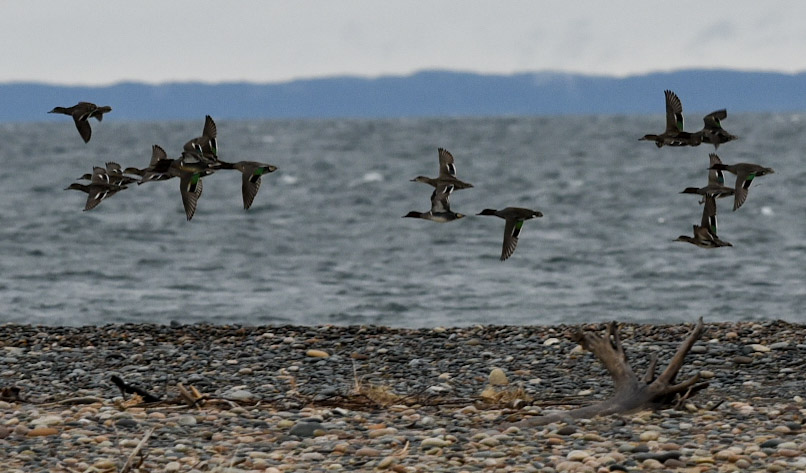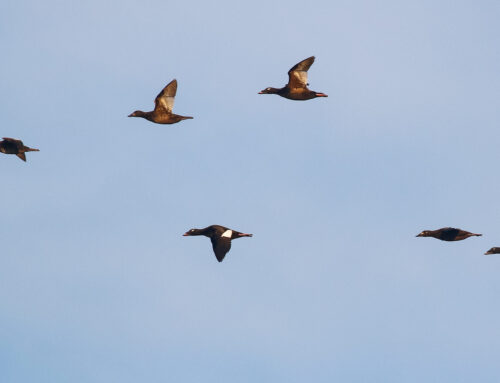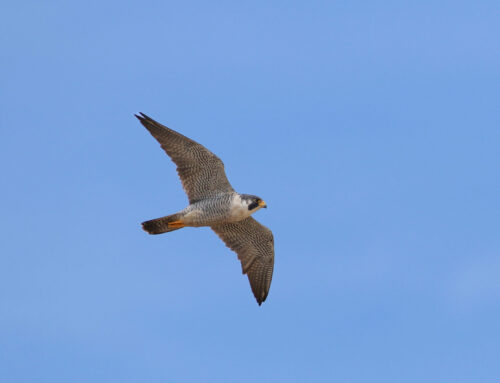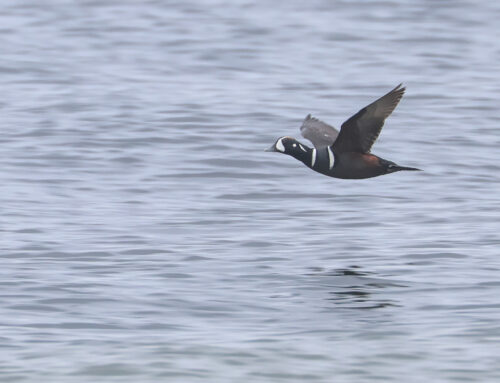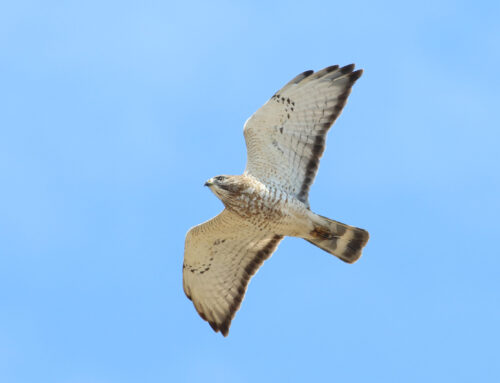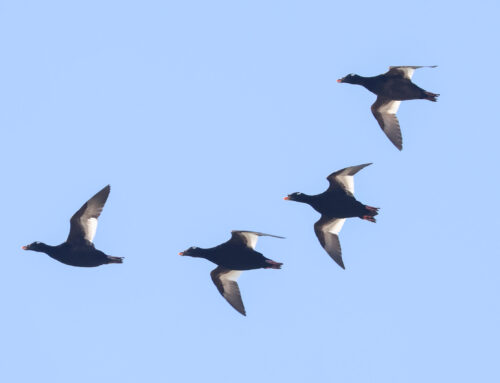Loon migration at WPBO is currently approaching full throttle — today, May 1, I had what is, so far, the season’s highest daily counts of Common (277) and Red-throated (38). With weather and season being what they are, I anticipate that Common Loons will peak within the next few days. (Last year, that happened on May 5, with a tally of 658.) I consider the loon movement at WPBO to be one of the most charismatic waterbird migrations: the rush of the wings when they pass directly above the waterbird shack; the haunting call so evocative of the northwoods; the symmetrical beauty of their flocks — scattered, compared to tight flocks of scaup or teal — but attractively spaced. Staggered strings of a couple dozen or so spool out across great swaths of sky. In comparison to the other waterbirds we count at WPBO, loons travel a wide variety of flight lines. Some have a proclivity to fly right overhead, while others cut the tip and sneak away over the pines. Many, of course, do follow the shoreline northwest. On high-volume loon days, it is especially important to keep tabs on all your available horizons.
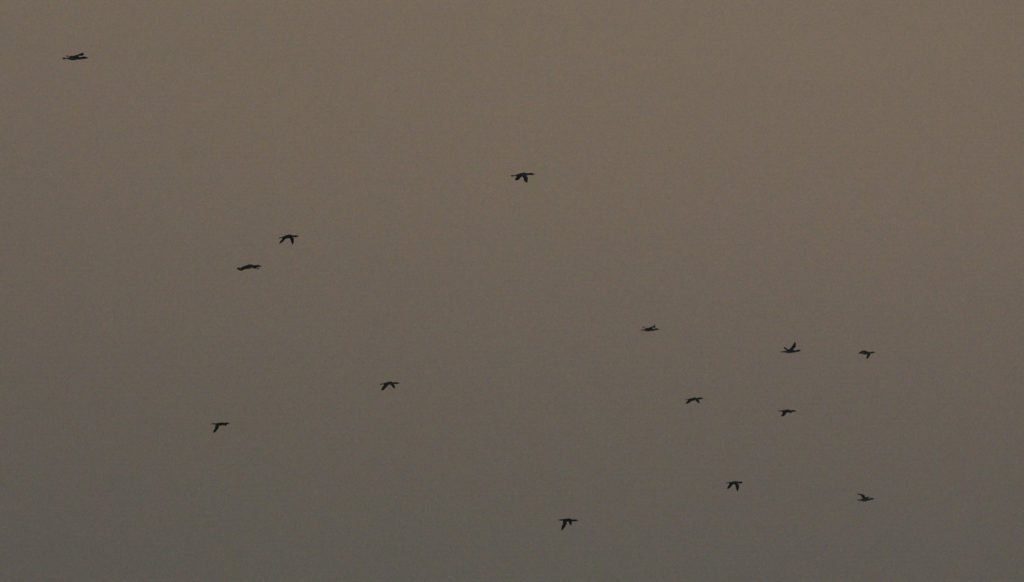
Loon flock in flight, WPBO. Vilag photo.
A great gift that comes as collateral when you work as a counter is the practice of prolonged, intentional observation. For eight hours each day, I occupy an existence where the most important act is to, with all senses, be aware. Within this space, nuance is frequently encountered.
One of this week’s discoveries has brought me much happiness. I am certain it is not new to science, and I am probably not the first WPBO counter to notice it. It is, however, new to me and I really dig the element of discovery. This time of year, there often is a loon or a few loafing just offshore the Point, sometimes joined by a handful of Red-breasted Mergansers and Red-necked Grebes. The loons call periodically — something that just never gets old. But recently, I noticed that whenever the swimming loon called, a migrating loon was somewhere overhead.
(I noticed, too, that it was always the same type of call — this video from Cornell deciphers it as territorial.) The swimming loon is at least as good at detecting flying loons as I am — in fact, in some regards, it may be better — that loon does not seem to misidentify loons in flight. I, on the other hand, do not have a perfect record. Several times today, the loon’s calling helped me get on birds overhead; when I left the count this afternoon, I thanked it for its assistance.
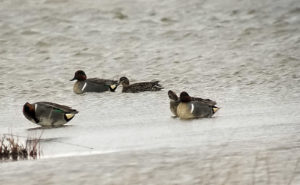 Loons aside, it actually has been a very fun week at the waterbird count. Caspian Tern, Dunlin, and Northern Shoveler are new arrivals for the season; Wednesday, April 27, was a great dabbler and Aythya flight (especially for Northern Pintail, 32 and Greater Scaup, 141; Greater Yellowlegs were also prominent, with a large chunk of the day’s total coming from a flock of 27); April 28, I found plenty of excuses to let my scope linger on a dapper flock of Green-winged Teal resting in the Point pond (the flock numbered 25 — last spring, the entire season’s total was just 12…). Finally, today, I had a single Willet. This species is not recorded every year on the waterbird count.
Loons aside, it actually has been a very fun week at the waterbird count. Caspian Tern, Dunlin, and Northern Shoveler are new arrivals for the season; Wednesday, April 27, was a great dabbler and Aythya flight (especially for Northern Pintail, 32 and Greater Scaup, 141; Greater Yellowlegs were also prominent, with a large chunk of the day’s total coming from a flock of 27); April 28, I found plenty of excuses to let my scope linger on a dapper flock of Green-winged Teal resting in the Point pond (the flock numbered 25 — last spring, the entire season’s total was just 12…). Finally, today, I had a single Willet. This species is not recorded every year on the waterbird count.
Happy May, and thank you for reading! I post eBird checklists daily and — as always — you can follow the count live on Dunkadoo.
–Alison Vilag, WPBO Waterbird Counter. (Featured image: Green-winged Teal. Vilag.)
If you are considering visiting the Point, please read this important message from Michigan Audubon and WPBO Field Staff.
Maneuvering the ever-changing implications of COVID-19 has necessitated constant adaptation and evaluation for us all. Michigan Audubon and WPBO have been proactive in taking measures that protect our staff, our physical community in Paradise, and the Michigan birding community, and we have found American Birding Association’s recent guidelines on birding and social distancing a useful resource for guiding bird-related travel decisions. While there are hopeful signs that we are rounding the corner with this virus, Michigan Audubon does not want to sow precocious optimism that encourages long-distance travel. Please take a minute to read these ABA guidelines, and to imagine them through the lens of the eastern Upper Peninsula, which does not have the medical resources of Michigan’s more-developed areas. Chippewa County and its adjacent counties have just three hospitals, and only one of these has more than 100 beds; they all are at least an hour’s drive from the Point. WPBO appreciates and requests your continued conscientiousness as the season’s migration begins to ramp up, and does not condone birding travel that is not local. Keep in mind that the Owl’s Roost Gift Shop and public observation of owl banding are currently closed. In the meantime, we will virtually share the Point with you as best we can until it is safe for all parties to enjoy it together. We hope that will be soon.

